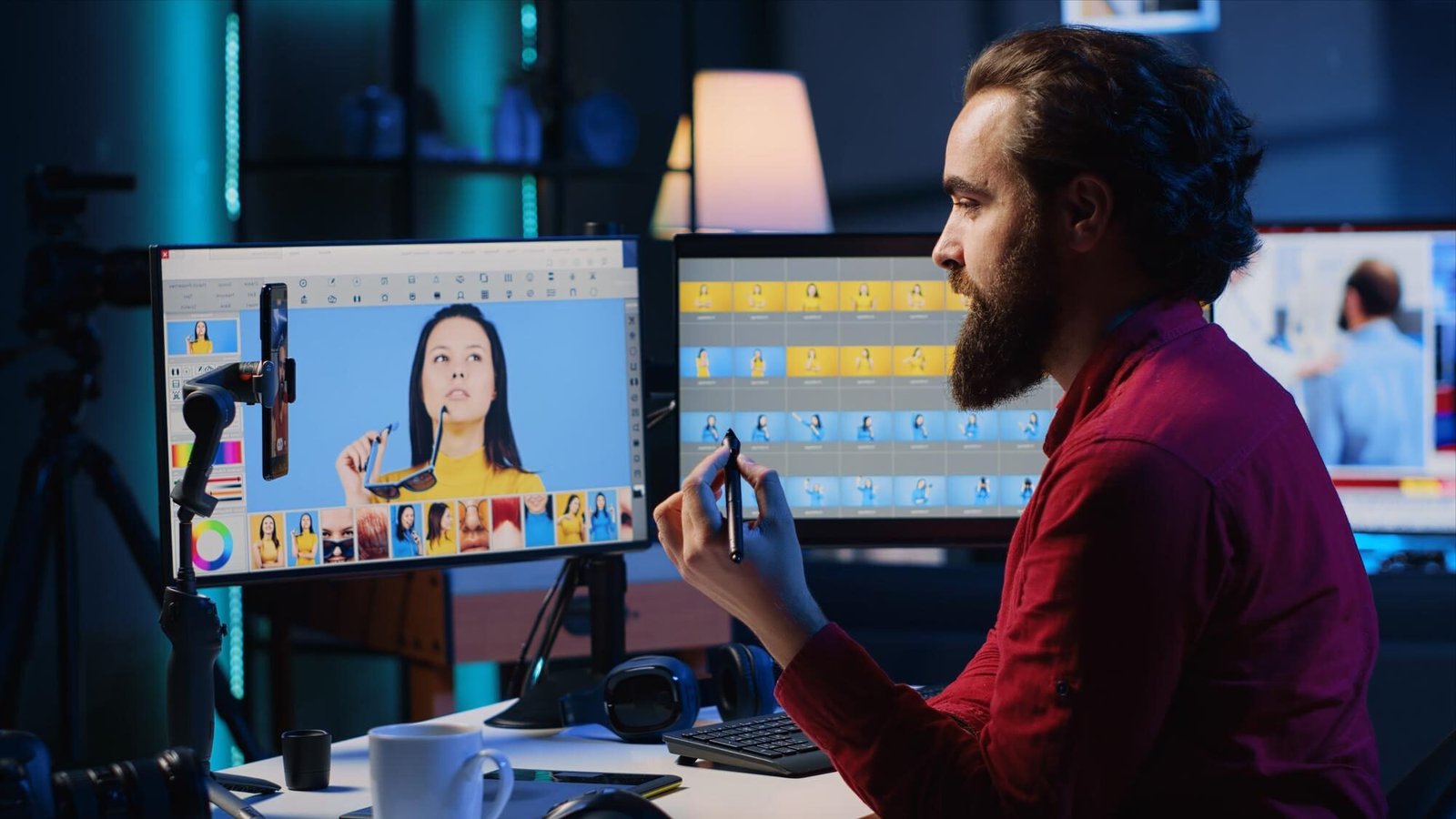
Unlocking the Power of Creativity: Navigating a Successful Career in Graphic Design
Unlocking the Power of Creativity: Navigating a Successful Career in Graphic Design
Are you a creative mind with a passion for design? Do you dream of turning your artistic skills into a successful career in graphic design? If so, then this article is for you. Unlocking the Power of Creativity: Navigating a Successful Career in Graphic Design takes an in-depth look at the keys to thriving in the dynamic field of graphic design.
In this article, we will explore essential strategies for unleashing your creative potential, building a strong portfolio, and staying ahead of the curve in an ever-changing industry. From honing your technical skills to developing a personal brand, we provide actionable advice to help you succeed.
Whether you’re a seasoned professional looking to take your career to the next level or a beginner just starting out, this article is designed to equip you with the knowledge and inspiration to navigate the competitive world of graphic design. So grab your sketchbook or fire up your digital design software, and get ready to unlock the power of your creativity in the exciting field of graphic design.
The importance of creativity in graphic design
Creativity is the heart and soul of graphic design. It is the driving force that transforms a simple idea into a visually captivating masterpiece. In a field where aesthetics play a crucial role, the ability to think outside the box and bring unique concepts to life is paramount. Creativity allows graphic designers to communicate messages effectively, engage audiences, and evoke emotions through visual storytelling. This makes it an invaluable asset, as clients often seek designers who can elevate their brands through innovative design solutions that stand out in a crowded marketplace.
Moreover, creativity is not just about artistic flair; it also involves problem-solving. Graphic designers frequently face challenges that require them to find effective visual solutions to meet specific client needs. Whether it’s creating a logo that encapsulates a company’s mission or designing a user-friendly interface for an app, each project demands a thoughtful approach that combines creativity with functionality. This synthesis of artistic and analytical skills is what sets successful graphic designers apart from their peers.
Additionally, in an industry that is constantly evolving with new trends and technologies, creativity ensures that designers remain relevant. It drives continuous learning and experimentation, encouraging designers to explore new styles, techniques, and mediums. By embracing creativity as a core value, graphic designers can adapt to changes in the industry, push their own boundaries, and ultimately achieve greater success in their careers. The ability to innovate not only enriches the designer’s portfolio but also enhances their reputation, making them a sought-after professional in the graphic design community.
Skills and qualities needed for a successful graphic design career
To thrive in the competitive world of graphic design, a diverse set of skills and qualities is essential. First and foremost, technical proficiency in design software is crucial. Familiarity with tools such as Adobe Creative Suite (Photoshop, Illustrator, and InDesign) is often a prerequisite for most design jobs. However, beyond knowing how to use these tools, understanding design principles like color theory, typography, and layout is equally important. A solid grasp of these fundamentals enables designers to create visually appealing and effective designs that resonate with the target audience.
In addition to technical skills, strong communication and collaboration abilities are vital for graphic designers. Designers often work closely with clients, marketing teams, and other stakeholders to bring a vision to life. Being able to articulate ideas and receive constructive feedback is essential for successful project outcomes. Furthermore, good interpersonal skills can facilitate smoother collaboration and lead to more fruitful partnerships, ultimately enhancing a designer’s career prospects.
Another important quality is adaptability. The graphic design landscape is constantly changing, influenced by new trends, technologies, and consumer preferences. Successful designers are those who can quickly adapt to these shifts and incorporate them into their work. This flexibility not only keeps their designs fresh and relevant but also demonstrates a willingness to learn and grow in a fast-paced environment. Coupled with a passion for creativity, these skills and qualities form the foundation of a successful career in graphic design.
Navigating the graphic design industry
Navigating the graphic design industry can be both exciting and challenging. Understanding the landscape is vital for any aspiring designer, as it allows them to identify opportunities and carve out their niche. One of the first steps in this journey is gaining a clear understanding of the different types of graphic design, including branding, advertising, web design, and illustration. Each specialization comes with its demands and expectations, and being aware of these differences can help designers tailor their skills to meet industry needs.
Furthermore, staying informed about industry trends and emerging technologies is essential for navigating the graphic design landscape. With the rise of digital media, graphic designers must be proficient in various digital platforms and keep abreast of the latest design tools and software. Engaging with online resources, attending workshops, and participating in industry conferences are excellent ways to remain informed and connected to the pulse of the industry. This knowledge not only enhances a designer’s skill set but also enables them to offer relevant solutions to clients.
Lastly, understanding the business side of graphic design is crucial. Many designers find themselves freelancing or starting their own design studios, which requires knowledge of marketing, client management, and financial planning. Learning how to effectively pitch to clients and negotiate contracts can make a significant difference in a designer’s career trajectory. By combining creative talent with business acumen, graphic designers can navigate the industry more effectively and position themselves for long-term success.
Building a strong portfolio
A well-crafted portfolio is a designer’s most powerful marketing tool. It serves as a visual resume that showcases a designer’s skills, style, and versatility. Building a strong portfolio begins with selecting a diverse range of work that highlights different aspects of one’s design capabilities. Including projects that demonstrate not only creativity but also problem-solving skills and the ability to meet client requirements is essential. Potential clients and employers often look for evidence of a designer’s ability to adapt to various styles and project demands, making diversity in the portfolio crucial.
An effective portfolio should also tell a story. Each piece should be accompanied by context, such as the problem being addressed, the design process, and the final outcome. This narrative helps viewers understand the designer’s thought process and the value they brought to each project. Including testimonials or feedback from clients can further enhance credibility and provide insights into the designer’s work ethic and collaboration skills. A well-documented journey through one’s design projects can leave a lasting impression on potential clients and employers.
In today’s digital age, having an online portfolio is vital. Platforms such as Behance, Dribbble, and personal websites allow designers to showcase their work to a global audience. Additionally, a strong online presence can facilitate networking opportunities and attract potential clients. Designers should ensure that their online portfolio is not only visually appealing but also user-friendly, with easy navigation and responsive design. Regularly updating the portfolio with new projects and relevant work is equally important to keep it fresh and reflective of the designer’s current skill level.
Networking and building connections in the graphic design community
Networking is an essential component of a successful graphic design career. Building connections within the design community can open doors to job opportunities, collaborations, and valuable mentorship. One effective way to network is by attending industry events, such as design conferences, workshops, and meetups. These gatherings provide opportunities to meet like-minded individuals, share experiences, and learn from established professionals. Engaging in conversations and exchanging ideas can lead to lasting relationships that may benefit one’s career in the long run.
In addition to in-person events, leveraging online platforms is equally important for networking. Social media sites like LinkedIn, Instagram, and design-specific platforms such as Dribbble and Behance allow designers to connect with peers, showcase their work, and engage with industry leaders. Joining design-related groups and forums can facilitate discussions and provide insights into industry trends and job openings. Actively participating in these online communities can help designers establish their presence and foster connections that can lead to future collaborations and freelance opportunities.
Moreover, seeking out mentorship is a valuable strategy for professional growth. Mentors can offer guidance, feedback, and insights based on their experiences in the industry. Finding a mentor can be accomplished through networking events or online platforms, where established designers may be open to sharing their knowledge with emerging talent. Building relationships with mentors can provide crucial support during the early stages of a designer’s career and help navigate challenges that may arise along the way. Investing time and effort in networking can significantly impact a designer’s career trajectory.
Tools and software for graphic designers
In the realm of graphic design, proficiency in various tools and software is fundamental to executing creative visions effectively. Adobe Creative Suite remains the industry standard, with Adobe Photoshop, Illustrator, and InDesign being the most widely used applications. Photoshop is invaluable for photo editing and manipulation, allowing designers to create stunning visuals. Illustrator excels in vector graphics, making it ideal for logo design and illustrations. InDesign is essential for layout design, particularly for print projects such as brochures and magazines.
Mastery of these tools can significantly enhance a designer’s workflow and output quality. In addition to Adobe products, numerous other tools can complement a designer’s skill set. Sketch and Figma have gained popularity for web and user interface design, providing collaborative features that streamline the design process. Canva is another user-friendly platform that allows designers to create graphics quickly, making it an excellent tool for social media and marketing materials. Each of these tools provides unique features that can help designers execute their ideas more efficiently, thus enhancing productivity and creativity.
Staying updated with the latest design software and tools is crucial for maintaining a competitive edge. The landscape of graphic design tools is constantly evolving, with new technologies emerging regularly. Following software updates, participating in online tutorials, and exploring new applications can help designers stay current and enhance their skill sets. Embracing a variety of tools not only allows for greater flexibility in design work but also empowers designers to adapt to the specific needs of each project, ultimately leading to more successful outcomes.
Staying updated with industry trends and technology advancements
In the fast-paced world of graphic design, staying updated with industry trends and technological advancements is crucial for success. The design landscape is ever-evolving, influenced by cultural shifts, emerging technologies, and changing consumer preferences. Designers must remain vigilant in tracking these trends to ensure their work remains relevant and appealing to clients. Subscribing to design magazines, following influential designers on social media, and participating in online design communities are effective ways to stay informed about the latest developments in the industry.
Moreover, understanding the impact of technology on design practices is essential. With advancements in artificial intelligence, augmented reality, and virtual reality, designers are presented with new opportunities and challenges. Embracing these technologies can lead to innovative design solutions and a more engaging experience for the audience. For instance, incorporating AR elements into marketing materials can create interactive experiences that captivate consumers and enhance brand engagement. By staying ahead of technological advancements, designers can differentiate themselves and offer cutting-edge solutions to their clients.
Additionally, attending workshops, webinars, and conferences can provide valuable insights into industry trends and best practices. These events often feature discussions led by industry leaders, offering a wealth of knowledge that can inspire and inform designers. Engaging with peers in these settings can also foster collaboration and idea-sharing, creating a vibrant learning environment. By actively pursuing opportunities for professional development, designers can cultivate their skills and stay at the forefront of the graphic design industry.
Balancing creativity and client requirements
One of the most significant challenges graphic designers face is balancing their creative vision with client requirements. While creativity is essential for producing unique and compelling designs, clients often have specific goals, brand guidelines, and target audiences that must be considered. Striking this balance is a delicate process that requires effective communication and collaboration with clients. Understanding their needs and expectations from the outset can help designers align their creative concepts with the client’s vision, resulting in a successful outcome.
In some cases, designers may need to educate clients about design principles and the rationale behind their creative choices. This can involve presenting multiple design concepts, explaining the reasoning behind each approach, and highlighting how they align with the client’s goals. By fostering an open dialogue, designers can build trust and demonstrate their expertise, ultimately leading to a collaborative environment where creativity can flourish within the constraints of client requirements.
Furthermore, flexibility is key in navigating this balancing act. Designers should be prepared to iterate on their designs based on client feedback while also advocating for their creative instincts. This may involve refining a concept to better suit the client’s needs or, conversely, presenting alternative solutions that may enhance the project’s overall impact. The ability to adapt while maintaining a strong creative vision is what distinguishes successful graphic designers, enabling them to deliver exceptional work that meets both artistic and client demands.
Conclusion and final thoughts
In conclusion, a successful career in graphic design hinges on the ability to unlock and harness creativity while navigating the complexities of the industry. By understanding the importance of creativity, cultivating essential skills, and building a strong portfolio, aspiring designers can position themselves for success. Networking within the design community and staying updated with tools and trends further enhance a designer’s ability to thrive in this dynamic field.
As designers continue to face the challenge of balancing their creative instincts with client requirements, embracing flexibility and effective communication will be crucial to their growth and success. By fostering collaborative relationships with clients and remaining adaptable, graphic designers can create impactful work that resonates with audiences and fulfills project objectives.
Ultimately, the journey in graphic design is one of continuous learning and exploration. The industry is ever-evolving, offering new opportunities for those willing to embrace change and innovation. With dedication, passion, and a commitment to honing their craft, graphic designers can unlock the full potential of their creativity and navigate a successful and fulfilling career in this exciting field

